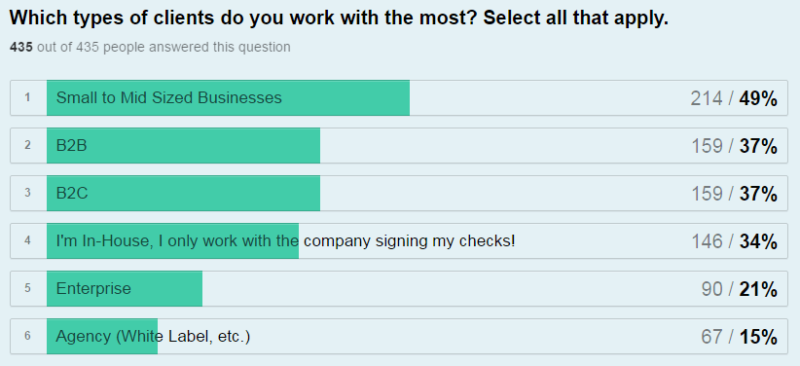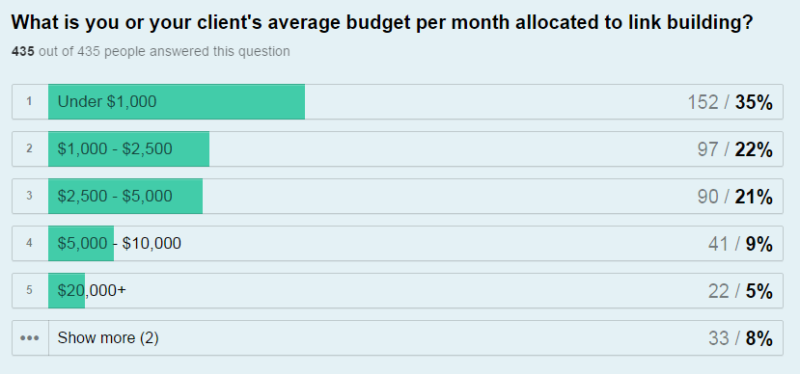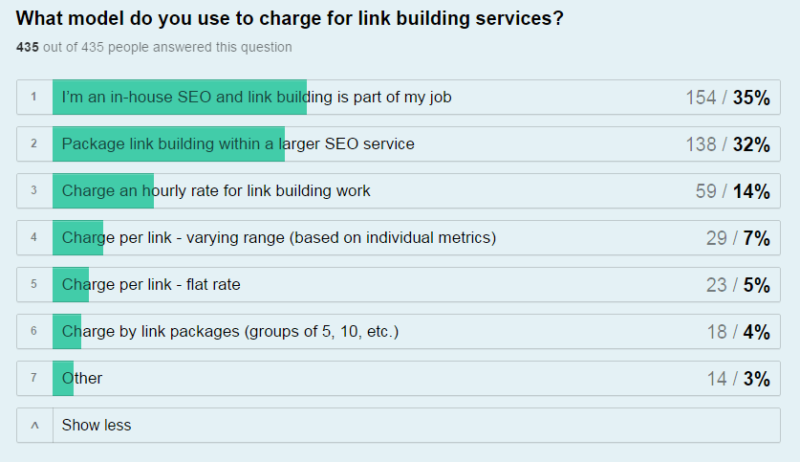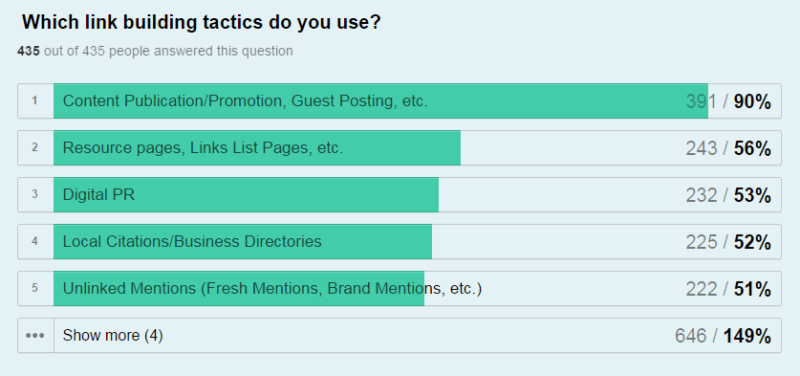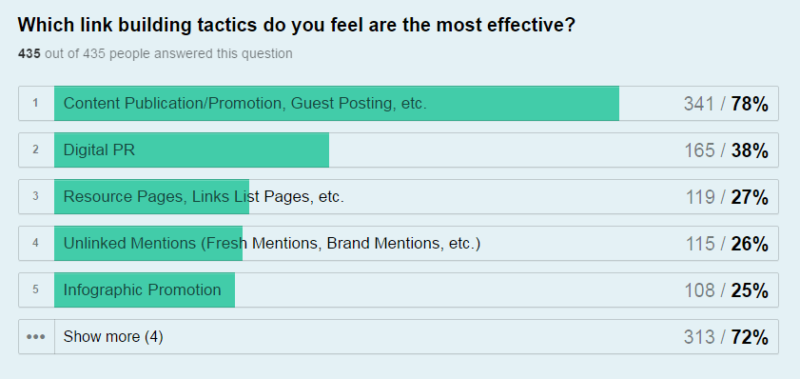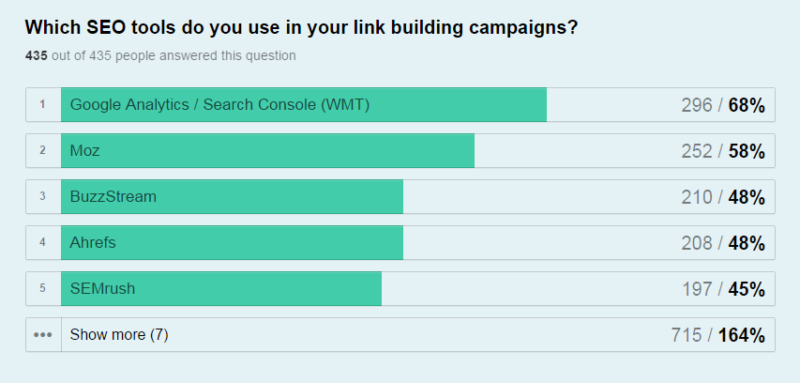2016 State of Link Building Survey coverage
What does modern-day link building look like? Columnist Andrew Dennis explores the results of a 2016 survey on link building conducted by Moz, Credo and Page One Power.

Link acquisition is always changing.
Tactics, perceptions, and even the way search engines evaluate links are continuously evolving. Because of the ever-changing nature of link building, it’s always interesting to examine the state of the industry.
Recently, my colleague Nicholas Chimonas partnered with Moz and Credo to conduct a link-building industry survey. Nicholas detailed his process and the results from the survey in an excellent post on Moz.
I want to cover some of the key takeaways from this survey and offer my own insight and opinions on the current state and future of link building.
Here are some quick, high-level stats on the survey participants:
- 435 people participated in the survey.
- Most work at agencies (42 percent) or are in-house employees (27 percent).
- The majority work at companies with 1–50 employees (65 percent).
- A large portion work alone (33 percent) or in teams of two to five people (47 percent), with varying structures.
- Most spend 1–25 percent (36 percent) or 26–50 percent (34 percent) of their time/work on link acquisition.
This data provide some context as to who responded to the survey.
Let’s dive deeper into the survey results, looking at some specific areas.
Link-building clients
The results from the survey provide some insight into what types of companies are purchasing link acquisition as a service.
According to the survey results, half of the participants serve clients that would be categorized as small to medium-sized businesses (SMBs).
It makes sense that the majority of the survey respondents service SMB clients, because search is often the best platform for these smaller companies to compete online, particularly organic search. Effective link-building levels the playing field, making it possible for smaller businesses to compete in the search results with big brands.
On the flip side, 21 percent of survey participants indicated they work with enterprise-level clients. I predict this percentage will be higher next year, as more and more big brands begin to realize they are missing out on important opportunities.
I believe links will continue to grow as a key performance indicator (KPI) within the larger scope of digital marketing (not just the SEO department), and we will see more big brands investing in link development.
Budgets and pricing models
The data from the survey also shed some light on client budgets and vendor pricing models.
Highlights of the budgets distributions include:
- Just over a third (35 percent) of clients spend less than $1,000 per month on link building.
- Five percent of clients have link-building budgets of $20,000+, and three percent have link-building budgets in the $10,000–$20,000 range.
- Just over half (53 percent) of clients allocate a quarter or less of their SEO budget to link building.
The fact that 35 percent of respondents indicated their clients’ budgets are under $1,000 correlates with the data showing the majority of link-building clients are SMBs.
I also found it interesting that eight percent of respondents had clients with average monthly link-building budgets of $10,000 or more. These are very large budgets, and I believe this is an indication of major enterprise companies awakening to the power of links online.
Speaking of the power of links, it’s interesting to see that a majority (53 percent) of survey takers specified that their clients allocate 25 percent or less of their total SEO budget to link acquisition.
This number is even more interesting when compared to the survey data regarding what percentage of SEO work is focused on link acquisition, where 64 percent of respondents reported that over 25 percent of their SEO work is dedicated to securing links.
The survey also provided some interesting statistics about agency pricing models.
The majority of respondents to this question identified as in-house SEOs (35 percent), with link building being a part of their job. Outside of that, packaging link building into a larger SEO service led the way (32 percent).
There appear to be a few different ways people use the charge-per-link model, which constituted 16 percent of the responses. These models include charging per link with varying ranges (seven percent), charging a flat rate per link (five percent) and charging by link packages (four percent).
Charging an hourly rate seemed to be the less-used option, at 14 percent.
The results from the survey demonstrate how the pricing models for link acquisition can vary greatly from vendor to vendor.
Tactics and tools
The survey also covered popular link-building tactics and tools.
Content publication/promotion was far and away the most popular tactic; 90 percent of participants said they employ content as a link-earning tactic.
Resource link building was the second most popular tactic listed (56 percent), narrowly ahead of digital PR (53 percent). Also worth noting was that a fair number of respondents (22 percent) still use “old school” techniques like press release submissions and social bookmarking.
Respondents also indicated which tactics they felt were most effective, with content publication/promotion ranking number one again.
Although 90 percent of respondents reported using content publication/promotion as a link-building tactic, only 78 percent felt it was the most effective. This made me think of the recent BuzzSumo and Moz study, which found that the vast majority of content published online struggles to secure links.
One of the most interesting takeaways is that while resource link building edged out digital PR in terms of usage, digital PR was clearly viewed as the more effective tactic. I believe the reason digital PR is viewed as more effective, but is not always implemented, is that it is difficult to execute.
Securing links through digital PR is literally impossible without a successful publicity campaign. Furthermore, even with a successful campaign, you still need open communication and collaboration to successfully execute on the link opportunities that are created. Of course, link building should never be done in a vacuum, but successful integration isn’t easy and takes dedicated, sustained effort.
Unsurprisingly, while 22 percent of participants use “old school” tactics, only seven percent view them as effective. I surmise this is a number that has been dwindling ever since Penguin launched in 2012.
Survey participants also highlighted their favorite link acquisition tools.
It was good to see Google Analytics and Search Console leading the pack (68 percent), but I expected a higher percentage. After all, it’s very difficult to track progress and measure success within a link campaign without data from these sources. One possible reason for this number being lower than expected could be that some clients might not allow their agency to have access to their Google Analytics.
For non-Google tools, Moz was a clear favorite, with 58 percent of survey respondents reporting that they use Moz for their link-building campaigns. This is not surprising, considering that Moz helped promote the survey to their audience, has a large suite of tools and is a very recognizable brand.
BuzzStream, Ahrefs, SEMrush, BuzzSumo, Majestic and Screaming Frog all had strong showings, hovering around the 40-percent range.
SimilarWeb, URL Profiler and Pitchbox all appear to be popular up-and-comers (seven to 13 percent).
It’s clear from the survey that those of us in the link acquisition industry love our tools.
Thank you to Moz, Credo and Page One Power for organizing this survey and providing such interesting data.
Contributing authors are invited to create content for Search Engine Land and are chosen for their expertise and contribution to the search community. Our contributors work under the oversight of the editorial staff and contributions are checked for quality and relevance to our readers. The opinions they express are their own.
Related stories
